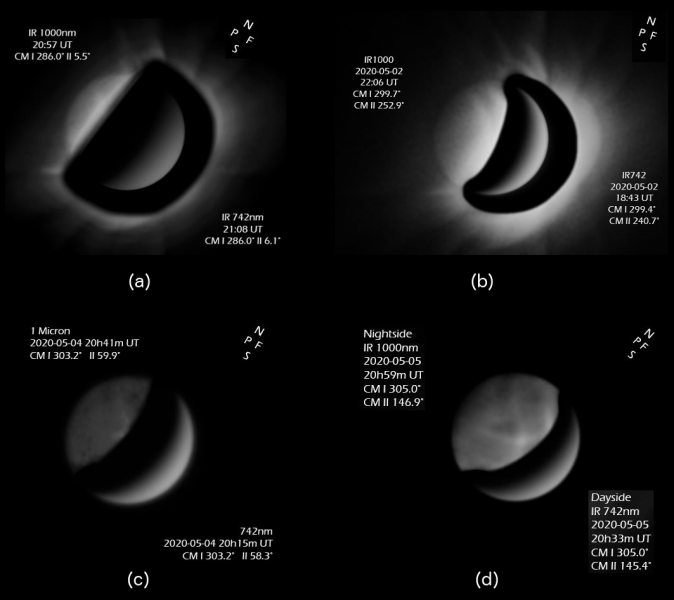The 2019–’20 eastern elongation of Venus, Part II: Observations of the nightside
2021 July 31
Introduction
This is the second part of a paper presenting the analysis and conclusions of amateur observations of the planet Venus during the 2019–’20 eastern elongation. In Part I we examined observations made of the sunlit hemisphere during this time.1 In this instalment, we examine observations made of the nocturnal hemisphere (nightside) of Venus.
To observers confined to visual and ultraviolet wavelengths, the planet is covered by a never-ending ocean of clouds. These clouds, although both striking and dynamic at short wavelengths, do nevertheless permanently obscure our view of the Cytherean surface. Prior to the 21st century, much of our information about the surface had to be established by spacecraft such as the NASA Magellan probe, which used radar to penetrate the clouds and provide a detailed map of the topography beneath.
In more recent times, advances in amateur astronomy have allowed observers to finally investigate the surface of Venus for themselves. This is done by capturing the infrared thermal emission (IRTE) of the nightside. The average surface temperature is about 737K (464°C),2 which means that the surface of the planet emits infrared (IR) radiation. The lower regions are hotter than the mountain peaks and therefore the lowlands appear brighter in IR images, while more elevated regions appear darker.
In longer wavelengths of the range λ ~ 780–2,500nm, the atmosphere of Venus is somewhat transparent, allowing hot glowing surface features to be imaged. An increasing number of amateurs have been involved in this work, and their results can be found in the report covering the elongations during 2007–’17.3
It has become increasingly clear over the last few years that Venus is likely to be a volcanically active world. Evidence to support this conclusion has been slowly gathering, but the results presented by Anna Gülcher et al. in Nature Geoscience, published in 2020 July, are particularly noteworthy.4 In this work, the authors used simulations to produce high-resolution images showing how volcanoes could form on the surface. Furthermore, these images predicted what active volcanic features would look like. By comparing the simulated imagery with Magellan data, the researchers found at least 37 sites which were likely to be volcanically active.
Recently, the Section has been involved in collecting and analysing amateur observations, with the aim of capturing active volcanism on the surface. These observations are made by imaging Venus, typically using IR filters with a passband of around 740nm to 1μm (one micron). This work has already produced a number of tantalising results: the bright features recorded by Wesley and Miles which were discussed by McKim (2019),3 and the extraordinary wave-like feature observed by Kardasis and others,5 can all be argued as supporting evidence for recent volcanic activity.
This has become one of the primary aims of the Section, and the Director strongly feels that it will be a fruitful line of scientific investigation. Amateur astronomers now have the technology to monitor the surface of Venus for long periods of time and provide greater coverage than a single space mission. If the volcanoes of Venus are indeed active, it is reasonable to suppose that it will be amateurs who provide conclusive proof and long-term monitoring. Members who are interested in pursuing this line of work can consult the Section newsletter Messenger, in which Martin Lewis has written an excellent introduction on how to observe Venus in the IR.6
The observations
Observations of the IRTE from the nightside of Venus can be made when the phase of the planet is below 30%. The smaller the phase, the more of the nightside is visible. One of the primary problems with this kind of work is in getting the exposure times correct and dealing with the brilliant crescent.
During the 2019–’20 eastern elongation, IRTE images were received from David Arditti, Frank J. Melillo, Pete Lawrence and Martin Lewis. Details of these observers can be found in Table 1, given in Part I of this paper.1
Lawrence obtained a series of nightside images at the end of April and early May, which are given in Figure 1.

By uploading the images into WinJUPOS, the longitude in CM1 (that of the surface) can be determined and some of the features visible in the images can be identified when compared to a map of the planet.7 In Figures 1c & d, the central bright spot is Undine Planitia, while the two bright features heading diagonally away from Undine towards the preceding limb are Beta Regio and Phoebe Regio. The darker region between them is Hinemoa Planitia. By imaging the planet at 1μm and 742nm, the nightside and the crescent have been captured and combined into a single image.
(Login or click above to view the full illustrated article in PDF format)
| The British Astronomical Association supports amateur astronomers around the UK and the rest of the world. Find out more about the BAA or join us. |
